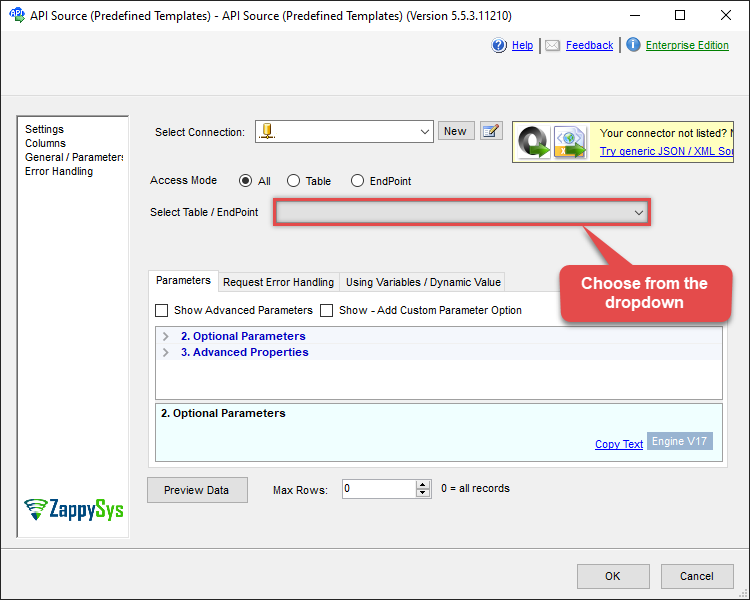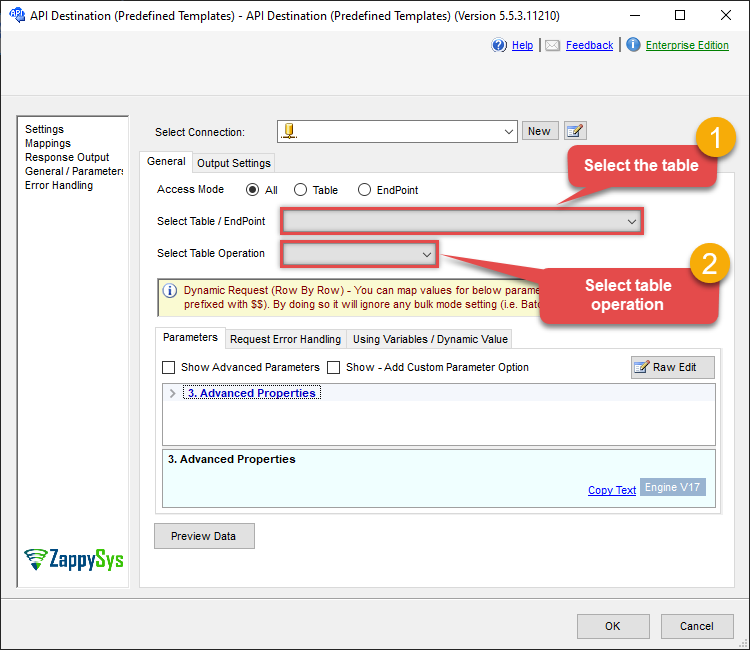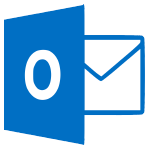Table MyMessages
Description
No description available
Supported Operations
Below section contains supported CRUD operations. Each operation is executed by some EndPoint behind the scene.| Method | Supported | Reference EndPoint |
|---|---|---|
| SELECT | get_my_messages | |
| INSERT | send_mail | |
| UPDATE | ||
| UPSERT | ||
| DELETE | ||
| LOOKUP | get_my_message |
Examples
SSIS
Use Outlook Mail (Office 365) Connector in API Source component to read data or in API Destination component to read/write data:
Read from MyMessages table using API Source
| There are no parameters to configure. |

Read/write to MyMessages table using API Destination
| There are no parameters to configure. |

ODBC application
Use these SQL queries in your ODBC application data source:
Get messages for the current user
SELECT * FROM MyMessagesGet a specific message from the current user's account by the message ID
SELECT * FROM MyMessages
WHERE Id='AAXkADIwNzNhODMyLTZiMTQtNDhiMC02OWQzLTc5YTY5M2IyMjk0NABGAyAAAACbj2hVuNphT74wylrfU4ixBwAbUV6IxRnpQrqzrb2WfacdAAAAAAEMAAAbUV6IxRnpQrqzrb2WfacdAAAysBnxAAA='Get messages for the current user ordered by the time they were sent in ascending order
SELECT * FROM MyMessages WITH (OrderBy='sentDateTime')Get messages for the current user ordered by the time they were sent in descending order
SELECT * FROM MyMessages WITH (OrderBy='sentDateTime desc')Get messages for the current user ordered by the time they were received in ascending order
SELECT * FROM MyMessages WITH (OrderBy='receivedDateTime')Get messages for the current user ordered by the time they were received in descending order
SELECT * FROM MyMessages WITH (OrderBy='receivedDateTime desc')Get messages for the current user ordered by the name of the sender in ascending order
SELECT * FROM MyMessages WITH (OrderBy='sender/emailAddress/name')Get messages for the current user ordered by the name of the sender in descending order
SELECT * FROM MyMessages WITH (OrderBy='sender/emailAddress/name desc')Send a simple email message (with headers, HTML body, recipients, attachments and more)
This example shows how to send email using Office 365 API. It shows how to attach local file(s) as attachments. To send email as Text format use Text rather than HTML in BodyContentType value.
INSERT INTO MyMessages
(Subject, BodyContentType, BodyContent
, ToRecipients, CcRecipients, BccRecipients
, InternetMessageHeaders
, Attachments, Importance, IsDeliveryReceiptRequested, IsReadReceiptRequested
, SaveToSentItems)
VALUES
('Employee Reviews Scheduled', 'HTML', '<b>Hi All,</b> employee reviews have been scheduled. <span style="text-decoration: underline;">Please reflect this in your notes.</span>',
'[{ "emailAddress": { "address": "john.doe@domain.com" }}, { "emailAddress": { "address": "jane.doe@domain.com" }}]',
'[{ "emailAddress": { "address": "mary.dawson@domain.com" }}]',
'[{ "emailAddress": { "address": "ryan.connor@domain.com" }}]',
'[{ "name": "x-custom-header-group-name", "value": "Managers" }, { "name": "x-custom-header-group-id", "value":"MGR001" }]',
'[
{
"@odata.type": "#microsoft.graph.fileAttachment",
"name": "file1.txt",
"contentType": "text/plain",
"contentBytes": "<<c:\file1.txt,FUN_FILE_BASE64ENC>>"
},
{
"@odata.type": "#microsoft.graph.fileAttachment",
"name": "profile-picture.png",
"contentType": "image/png",
"contentBytes": "<<c:\profile-picture.png,FUN_FILE_BASE64ENC>>"
}
]',
'normal', 'false', 'false', 'true')SQL Server
Use these SQL queries in SQL Server after you create a data source in Data Gateway:
Get messages for the current user
DECLARE @MyQuery NVARCHAR(MAX) = 'SELECT * FROM MyMessages';
EXEC (@MyQuery) AT [LS_TO_OUTLOOK_MAIL_OFFICE_365_IN_GATEWAY];Get a specific message from the current user's account by the message ID
DECLARE @MyQuery NVARCHAR(MAX) = 'SELECT * FROM MyMessages
WHERE Id=''AAXkADIwNzNhODMyLTZiMTQtNDhiMC02OWQzLTc5YTY5M2IyMjk0NABGAyAAAACbj2hVuNphT74wylrfU4ixBwAbUV6IxRnpQrqzrb2WfacdAAAAAAEMAAAbUV6IxRnpQrqzrb2WfacdAAAysBnxAAA=''';
EXEC (@MyQuery) AT [LS_TO_OUTLOOK_MAIL_OFFICE_365_IN_GATEWAY];Get messages for the current user ordered by the time they were sent in ascending order
DECLARE @MyQuery NVARCHAR(MAX) = 'SELECT * FROM MyMessages WITH (OrderBy=''sentDateTime'')';
EXEC (@MyQuery) AT [LS_TO_OUTLOOK_MAIL_OFFICE_365_IN_GATEWAY];Get messages for the current user ordered by the time they were sent in descending order
DECLARE @MyQuery NVARCHAR(MAX) = 'SELECT * FROM MyMessages WITH (OrderBy=''sentDateTime desc'')';
EXEC (@MyQuery) AT [LS_TO_OUTLOOK_MAIL_OFFICE_365_IN_GATEWAY];Get messages for the current user ordered by the time they were received in ascending order
DECLARE @MyQuery NVARCHAR(MAX) = 'SELECT * FROM MyMessages WITH (OrderBy=''receivedDateTime'')';
EXEC (@MyQuery) AT [LS_TO_OUTLOOK_MAIL_OFFICE_365_IN_GATEWAY];Get messages for the current user ordered by the time they were received in descending order
DECLARE @MyQuery NVARCHAR(MAX) = 'SELECT * FROM MyMessages WITH (OrderBy=''receivedDateTime desc'')';
EXEC (@MyQuery) AT [LS_TO_OUTLOOK_MAIL_OFFICE_365_IN_GATEWAY];Get messages for the current user ordered by the name of the sender in ascending order
DECLARE @MyQuery NVARCHAR(MAX) = 'SELECT * FROM MyMessages WITH (OrderBy=''sender/emailAddress/name'')';
EXEC (@MyQuery) AT [LS_TO_OUTLOOK_MAIL_OFFICE_365_IN_GATEWAY];Get messages for the current user ordered by the name of the sender in descending order
DECLARE @MyQuery NVARCHAR(MAX) = 'SELECT * FROM MyMessages WITH (OrderBy=''sender/emailAddress/name desc'')';
EXEC (@MyQuery) AT [LS_TO_OUTLOOK_MAIL_OFFICE_365_IN_GATEWAY];Send a simple email message (with headers, HTML body, recipients, attachments and more)
This example shows how to send email using Office 365 API. It shows how to attach local file(s) as attachments. To send email as Text format use Text rather than HTML in BodyContentType value.
DECLARE @MyQuery NVARCHAR(MAX) = 'INSERT INTO MyMessages
(Subject, BodyContentType, BodyContent
, ToRecipients, CcRecipients, BccRecipients
, InternetMessageHeaders
, Attachments, Importance, IsDeliveryReceiptRequested, IsReadReceiptRequested
, SaveToSentItems)
VALUES
(''Employee Reviews Scheduled'', ''HTML'', ''<b>Hi All,</b> employee reviews have been scheduled. <span style="text-decoration: underline;">Please reflect this in your notes.</span>'',
''[{ "emailAddress": { "address": "john.doe@domain.com" }}, { "emailAddress": { "address": "jane.doe@domain.com" }}]'',
''[{ "emailAddress": { "address": "mary.dawson@domain.com" }}]'',
''[{ "emailAddress": { "address": "ryan.connor@domain.com" }}]'',
''[{ "name": "x-custom-header-group-name", "value": "Managers" }, { "name": "x-custom-header-group-id", "value":"MGR001" }]'',
''[
{
"@odata.type": "#microsoft.graph.fileAttachment",
"name": "file1.txt",
"contentType": "text/plain",
"contentBytes": "<<c:\file1.txt,FUN_FILE_BASE64ENC>>"
},
{
"@odata.type": "#microsoft.graph.fileAttachment",
"name": "profile-picture.png",
"contentType": "image/png",
"contentBytes": "<<c:\profile-picture.png,FUN_FILE_BASE64ENC>>"
}
]'',
''normal'', ''false'', ''false'', ''true'')';
EXEC (@MyQuery) AT [LS_TO_OUTLOOK_MAIL_OFFICE_365_IN_GATEWAY];